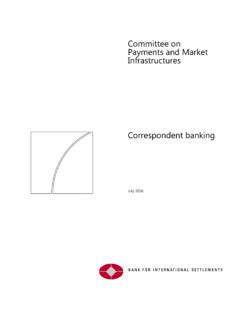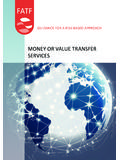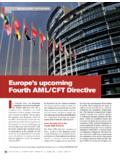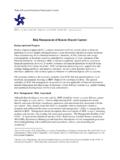Transcription of Basel Committee on Banking Supervision …
1 Basel Committee on Banking Supervision Consultative Document Guidelines Revised annex on correspondent Banking Issued for comment by 22 February 2017 November 2016 A final version of this report was published in June 2017. This publication is available on the BIS website ( ). Bank for International Settlements 2016. All rights reserved. Brief excerpts may be reproduced or translated provided the source is stated. ISBN 978-92-9259-009-3 (online) A final version of this report was published in June 2017. Revised annex on correspondent Banking iii Contents Revised annex on correspondent Banking .. 1 Background .. 1 Annex 2: correspondent Banking .. 2 Annex 4: General guide to account opening .. 11 A final version of this report was published in June 2017.
2 Final version of this report was published in June 2017. Revised annex on correspondent Banking 1 Revised annex on correspondent Banking correspondent Banking revisions to the Basel Committee guidelines on the Sound management of risks related to money laundering and financing of terrorism Background The text below includes proposed revisions to Annexes 2 ( correspondent Banking ) and 4 ( General guide to account opening ) of the Basel Committee on Banking Supervision (the Committee ) guidelines on the Sound management of risks related to money laundering and financing of terrorism first issued in January 2014 and revised in February 2016. The purpose of the proposed revisions is to ensure that banks conduct correspondent Banking business with the best possible understanding of the applicable requirements regarding anti-money laundering and countering the financing of terrorism.
3 The clarifications are proposed as the international community has been increasingly concerned about de-risking in correspondent Banking , since a decline in the number of correspondent Banking relationships may affect the ability to send and receive international payments, or drive some payment flows underground. The proposed revisions to the Committee s existing guidance follows the publication by the Financial Action Task Force (FATF) of its guidance on correspondent Banking services, issued in October 2016. The Committee seeks to clarify concrete regulatory expectations from Banking supervisors point of view consistent with the FATF standards and guidance. In preparing their publications on correspondent Banking , the FATF and the Committee worked closely with the FSB, which is coordinating work to assess the extent and address the causes of banks withdrawal from correspondent Banking , through the implementation of a four-point action plan (data collection and analysis, clarifications of regulatory expectations, domestic capacity-building and strengthening the tools for due diligence).
4 The proposed revisions develop the application of the risk-based approach for correspondent Banking relationships, recognising that not all correspondent Banking relationships bear the same level of risk. The risk indicators provided should help banks conduct their risk assessment (see in particular paragraphs 7 and 14 in Annex 2). The proposed revisions also clarify supervisors expectations regarding the quality of payment messages (see added Section VI, paragraphs 31 5) as well as conditions for using know your customer (KYC) utilities as recommended in the Committee on Payments and Market Infrastructures (CPMI) report on correspondent banking1 (see paragraph 18 in Annex 2 and added paragraphs 6bis and 6ter in Annex 4). Annex 4 has not been modified except for these two added paragraphs.
5 Respondents are invited to comment on the content of Annex 2, including on questions raised in boxes, and on proposed paragraphs 6bis and 6ter in Annex 4. 1 See Committee on Payments and Market Infrastructures, correspondent Banking , , July 2016. A final version of this report was published in June 2017. 2 Revised annex on correspondent Banking Annex 2 correspondent Banking I. General considerations on cross-border correspondent Banking 1. According to the FATF glossary, correspondent Banking is the provision of Banking services by one bank (the correspondent bank ) to another bank (the respondent bank ) . For the purpose of its guidance on correspondent Banking (hereafter the FATF guidance ),2 the FATF does not include one-off transactions but rather states that correspondent Banking is characterised by its ongoing, repetitive nature.
6 Like the FATF guidance, this Annex focuses on higher-risk correspondent Banking relationships, especially cross-border correspondent Banking . 2. Used by banks throughout the world, correspondent Banking services enable respondent banks to conduct business and provide services3 that they cannot offer otherwise (owing to the lack of an international presence and cross-border payment systems). As mentioned by the Financial Stability Board, the ability to make and receive international payments via correspondent Banking is vital for businesses and individuals, and for the G20 s goal of strong, sustainable, balanced 3. correspondent banks execute and/or process transactions for customers of respondent banks. correspondent banks generally do not have direct business relationships with these customers, which may be individuals, corporations or financial services firms, established in jurisdictions other than that of the correspondent bank.
7 Thus the customers of the correspondent bank are the respondent banks. 4. Because of the structure of this activity and the limited information available regarding the nature or purposes of the underlying transactions, correspondent banks may be exposed to money laundering and financing of terrorism (ML/FT) risks. II. Risk-based approach in the context of providing correspondent Banking services 5. The FATF guidance clarifies that, while correspondent Banking in general is considered higher-risk, not all correspondent Banking services carry the same level of ML/FT risks. The FATF guidance focuses on cross-border correspondent Banking relationships involving the execution of third-party payments that are This section provides factors that banks should take into account when assessing the level of risk of a particular correspondent Banking relationship.
8 2 FATF, Guidance on correspondent Banking services, October 2016, 3 Such as cash management (eg interest-bearing accounts in a variety of currencies), international wire transfers, cheque clearing, payable-through accounts and foreign exchange services . 4 See FSB, Progress report to G20 on the FSB action plan to assess and address the decline in correspondent Banking , August 2016, 5 See FATF, Guidance on correspondent Banking services, October 2016, paragraph 13a. A final version of this report was published in June 2017. Revised annex on correspondent Banking 3 A. Risk indicators and risk assessment 6. Banks that undertake correspondent Banking activities should assess the ML/FT risks associated with correspondent Banking activities.
9 7. Risk indicators that correspondent banks should consider in their risk assessment include: (1) the inherent risk resulting from the nature of services provided, in particular: (a) the purpose of the services provided to the respondent bank (eg foreign exchange services for respondents proprietary trading, securities trading on recognised exchanges or payments between a respondent s group within the same jurisdiction may constitute indicators of lower risk); (b) whether different entities of the group to which the respondent bank belongs would have access to the account; (c) the ability of other third parties to have access to the correspondent account, such as payable through accounts or nested relationships (see paragraph 10 below). (2) the characteristics of the respondent bank, in particular: (d) the respondent bank s major business activities including target markets and overall types of customers served in key business lines;6 (e) the respondent bank s management and ownership (including the beneficial owners) and whether they represent specific ML/FT risks (eg politically exposed persons (PEPs)); (f) the respondent bank s money laundering prevention and detection policies and procedures, including a description of the customer due diligence (CDD) measures applied by the respondent bank to its customers and the correspondent bank s ability to obtain information on a particular transaction as specified in paragraphs 32 3 of the FATF guidance.
10 7 (g) whether any civil, administrative or criminal actions or sanctions, including public reprimands, have been applied by any court or supervisory authority to the respondent bank. (3) the environment in which the respondent bank operates, in particular: (h) the jurisdiction in which the respondent bank (and its parent company when the respondent bank is an affiliate) is located; (i) the jurisdictions in which subsidiaries and branches of the group may be located, possibly using the group structure available in the Legal Entity Identifier (LEI) system,8 6 The correspondent bank should have a broad knowledge of the products and services offered and types of customers served by the respondent bank (see FATF guidance, paragraph 22). 7 The ability to obtain this information may depend on legal or technical permissibility.

















